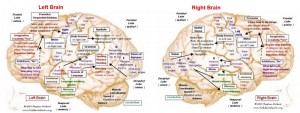Antidepressants have come a long way. Our understanding of the biological and neurological bases for depression has expanded vastly, and the number of treatment options have increased and improved so that they can be better targeted towards individual symptoms. Public knowledge has not kept pace; thanks to poor science education and journalism and the dissemination of false information by special interests, people understand much less about depression and its treatment than they should.
Tag Archives: Neuroscience
The Actual Science of Neuroplasticity!
So I’m watching something on TV, I don’t remember what, because I don’t do a lot of it, and pretty much every commercial break there’s an ad for Lumosity – “using the science of neuroplasticity!” This drives me nuts, because not only does it not work (more on that later) but it promulgates a failed understanding of what neuroplasticity is and what are its potentials and limitations.
Brain Function, Brain Anatomy Linky Goodness!
Do you want to understand the structure and function of your brain? Are you curious about how brain anatomy affects behavior and thinking? I have some good sites for you!

If you have to start somewhere, this site, The Brain from Top to Bottom is a great place. Not only is it indexed based on brain function, but you can select from three levels of understanding, based on your current knowledge of brain anatomy and functions.
UNDERSTANDING HOW THE BRAIN WORKS Written by Glen Johnson, a Clinical Neuropsychologist, this is a pretty understandable general overview.
MyBrainNotes™.com was written by Sarah-Neena Koch as a way to understand the structures of the brain and brain functions for a novel she was writing. The end result is pretty impressive – it’s pretty comprehensive while also being comprehensible. You should be able to understand it, and there are lots of embedded links.
Chapter Two of “Psychology, an Introduction” by Russ Dewey: The Human Nervous System has some description of brain anatomy and functions, and also covers certain deficiencies that result from brain injuries or hereditary differences. Again, more basic, because it’s not written for neurologists.
Patrick McCaffrey has an online syllabus and course supplements for a class on Neuroanatomy of Speech, Swallowing and Language and an equally informative set of pages on Neuropathologies of Language and Cognition
Anatomy of the Brain from The Mayfield Clinic is designed for patient education, and has illustrations to make the information more understandable.
Keith A. Johnson, M.D. and J. Alex Becker, Ph.D. from Harvard compiled The Whole Brain Atlas which takes a more neuroanatomical view with a focus on specific injuries and diseases.
The Allen Brain Atlas is “A growing collection of online public resources integrating extensive gene expression and neuroanatomical data, complete with a novel suite of search and viewing tools.”
“Welcome to Neuroscience Online, the Open-Access Neuroscience Electronic Textbook! This online, interactive courseware for the study of neuroscience is provided by the Department of Neurobiology and Anatomy at The University of Texas Medical School at Houston.”
